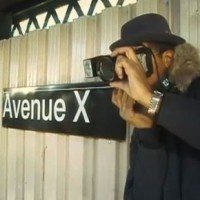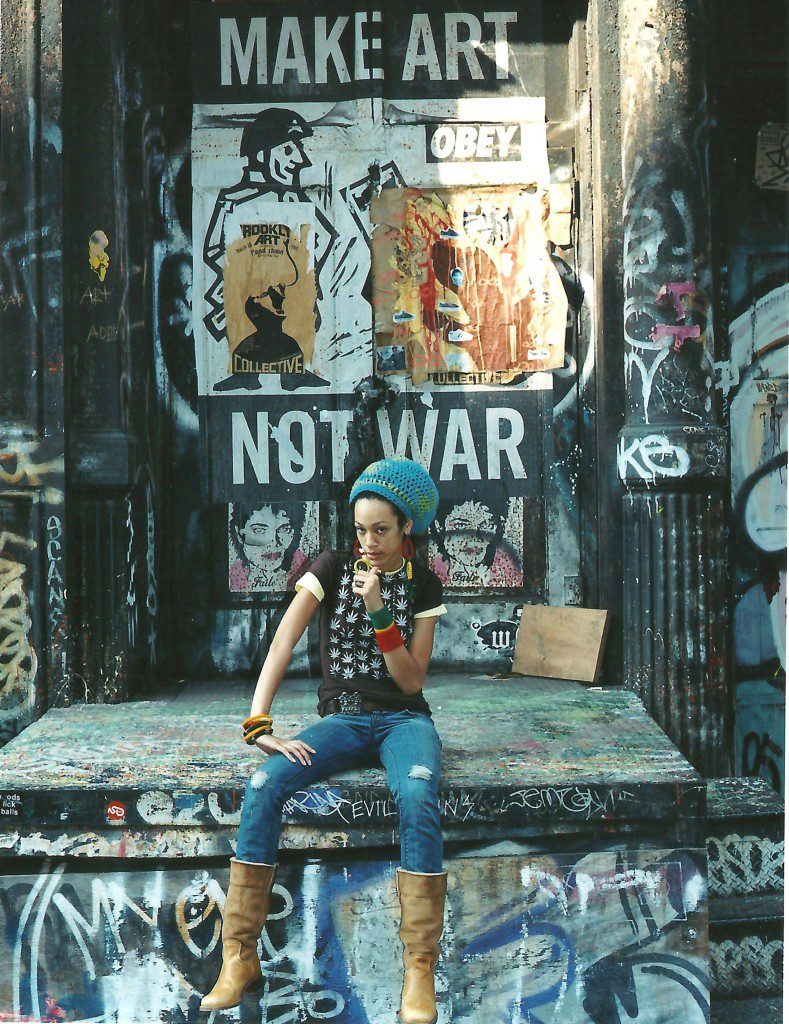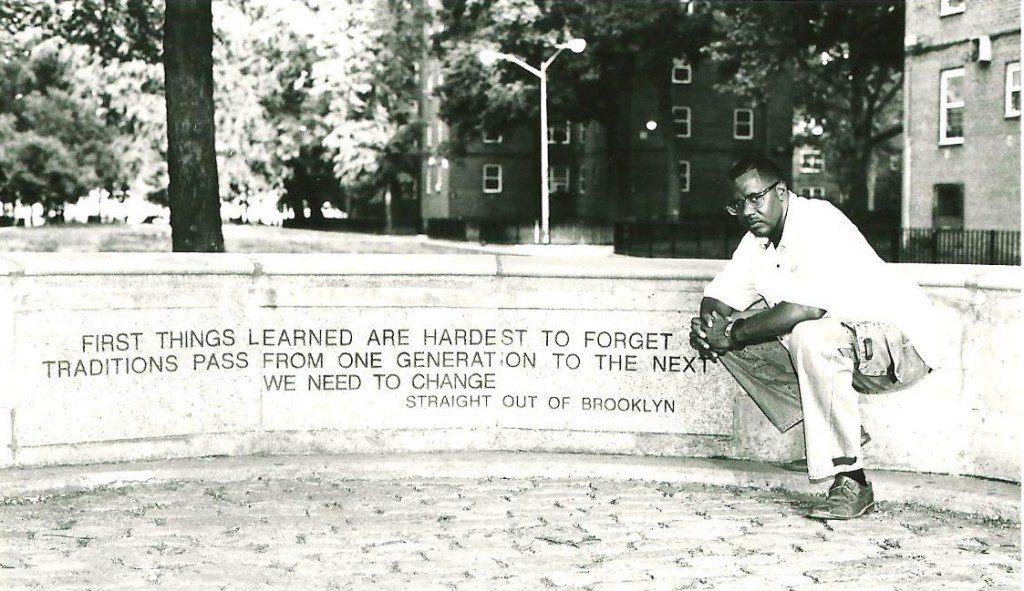For over thirty-five years, Jamel Shabazz has photographed the pulse of New York urban life. Dating back to the early days of hip-hop and B-boys, to the arrival of crack cocaine and the HIV/AIDs epidemic, and to the global commoditization of street style, Shabazz’s portraits tell the stories of everyday lives being lived in quotidian moments.
Shabazz’s portraits are a celebration of their subjects: dapper and fresh in their fashion, these individuals are impresarios of posing—on the streets, in front of stores, in subway cars. Yet, there is also an urgency to these images. Implied in each photograph is the relationship between the individual and the social spaces assigned in the entropy of urban existence.
Shabazz is known for the respect he has for his subjects, and the relationships he forges with them. Maybe this is why the eyes in the photographs are so immutable—once meeting his gaze, they are now meeting ours. His portraits offer a glimpse of the individual’s triumph against the social cage that holds them. But, as is the nature of photographs, what we see is momentary—after the click of the shutter, it’s back to the hard facts of life.
On a late fall afternoon, Jamel and I sat at a table outside the Brooklyn Public Library and discussed how he approaches his subjects, the inspiration he finds in war photography, and the importance of having compassion.
***
The Rumpus: What really brought me to your work was this: I was taking a photography class and my instructor told us what you say to a subject when asking to take their photograph: “Excuse me. My name is Jamel Shabazz, and I’m a photographer. When I see you, I see greatness. I see the future.”
Jamel Shabazz: When I approach a person, I feel a certain way. If I don’t feel that way, I’m not going to approach that individual. “I see something in you”—I want the person to know that. Often that person will ask, “What do you want my picture for?” So I already know that that question is going to come, and I say, “I sincerely see greatness in you. I see something special about you.” I may not always say “greatness.” I might just say, “I see something special about you. I don’t quite know what it is, but there is something special about you, and I want to capture it.”
Rumpus: When we see a great photo, we know it; there’s that split-second, almost physical recognition. We make a sort of eye contact with the photo. Yet, we cannot put into language what it is that makes the image so special. It’s almost like a similar thing happens between you and your subject. What is the process of approaching potential subjects like?
Shabazz: I think having a book now makes it easier because when they see you’ve got a book, they see that you’re legit. I place myself in situations where a lot of people are going to be, and bring a particular body of work that reflects the people already there. You have to study your subject. I have a few minutes to develop an idea of what I want to say to this person, how I’m going to shoot this person.
It’s about looking for body language and being sincere, being able to explain why. It could be the hair, it could be the eyes, it could be the clothing. I want them to see what I’m saying. It’s one thing to hear what you say, but when they can visualize what you are trying to say, they are more open.
Rumpus: So as a photographer, I would say, looking at you, I see something in you, just the way you wear your glasses—something like that? Something is particularly human in you at this instant?
Shabazz: Yes. And they can understand that. Maybe for [that] person: “Nobody’s ever told me that before.” They might feel [that] inside, but again, for you to recognize greatness in a person that others may not recognize, it makes them feel good that you saw it.
Rumpus: So, at the end of the day, it’s basically about sensitivity and human connection.
Shabazz: Totally, and that’s exactly it, too, because for me, it’s about engaging in conversation with people. My camera is my compass; it’s guided me to so many different places. The majority of the people I’ve taken photographs of, I’ve had conversations with. “What are your goals and aspirations?” “What are you about?” It’s not just about me capturing the image; I want to know what you are about.
I do believe in angels and I believe that a lot of these people I’m supposed to meet. The photograph serves as evidence; it causes me to reflect on when I met this person. The photograph is to a great degree evidence of the conversation I had with the person. It’s a part of my visual diary.
Rumpus: Do you have a favorite image that you’ve produced over the years?
Shabazz: One that stands out is a young boy flipping on a mattress in Brooklyn. That image is close to my heart because the process that I used is a direct result of the knowledge my father imparted to me.
Rumpus: The one on the cover of Seconds of My Life? That one’s breathtaking, truly. I love the way the children are holding their bodies, the expressions on their faces. What’s the story behind it?
Shabazz: I was walking in the neighborhood of Brownsville, and these kids had taken this old, beat-up raggedy mattress and improvised. These young acrobats were able to have fun, and show great skill and the ability to work that mattress, which I thought was phenomenal. Imagine if those kids would have gotten the right schooling, where they could have gone. For many kids, that was normal; when I published that photograph, so many people were able to relate. They’d say, “We used to do that all the time.” It goes to show you the potential alive in the community, if properly nurtured, where those kids could have gone. Where they are at now, I do not know.
Rumpus: I think this goes back to what is so significant about your portraiture. There is the vitality of the individual in your photos, that intimacy, but there is also the larger framing of urban life, the history of life on the streets. What photographers, besides your father, inspired you when you were younger?
Shabazz: The main book was a book that [my father had], Leonard Freed, who had documented black and segregated America in the 1960s, called Black and White America. There were photographs from New York City—also from the Deep South, from Mississippi, Alabama—that gave me a firsthand history lesson on [things] happening in America that weren’t being taught to me in history class. Philip Jones Griffith documented the Vietnam War, and through his images that were published in Time Life Magazine, it showed me the horrors of war and at that time, I wanted to be a war photographer, based off his work, and based off the work of Robert Capa, who documented the D-Day invasion during WWII.
There was James Vandersee, who documented the Harlem Renaissance; his work served as a benchmark, to what I’m doing today. I’m actually striving to continue what he’s doing, by documenting different fraternal organizations that exist, primarily in African American communities today.
Rumpus: What were some of the things that you valued about war photography, and what it could do, that has influenced your work in these different communities?
Shabazz: I think what it was with the war photography was the concerned eye, the desire to document these situations to show the world the horrors of war. It inspired me to document prostitution; inspired me to document homelessness in America. We are the richest country in the world, yet we have people suffering, so it helped me to look at things in that manner.
It helped me to train my lens, to better understand gang culture. I wanted to go amongst gangbangers, to understand this war they were fighting amongst each other. I wanted to document it, [also] to show the human side of it. So I think that images of war inspired me to create, to go to different situations and communities, to document the human side of people, to show a side that we don’t see. In the media, we might say “gangbanger,” and I’m shooting a gangbanger, but as a dignified man. That’s pretty much what war photography did: seeing images of soldiers in a dignified way. They might have been killers in Vietnam, but I’m seeing another side of them, and looking at images of the the American soldiers, also the North Vietnamese and the Viet Cong—I never saw an enemy. I think that’s what the war photography did for me. It showed me the human side of people and how certain circumstances can change people’s lives.
Rumpus: We think all of war is an aberration—and it is—but there are moments of dignity for people even in dire circumstances. I guess that you go deep into American social wars—poverty, homelessness, prostitution; these are wars in a different way, but just as bad. As a war photographer, you do the same thing by showing the dignity of these individuals in the face of what are horrific situations. Ultimately, you are telling the stories of “everyday people.”
Shabazz: There is just something about the common being. My education pretty much came from the streets, just connecting with people, different cultures. I gained the wealth just engaging at that level. I’m still like that. I continue to document everyday people versus the stars.
For me, the stars are the invisible people on the street that people don’t really get a chance to know. No one really tells a person that they have it, no one really sees the value in taking their photograph. ”Why you want to take my photograph for?” “Because I see something special in you, and I want to know who you are.”
Rumpus: I don’t think that we, as a society, make sure people know they have good qualities or give enough compliments.
Shabazz: As photographers, we can do that. And I think that that’s what photography has done for me. It has allowed me to have a voice. I used to stutter, and once I overcame that struggle, it felt good to tell people they were beautiful and special. I remember growing up and hearing the word “ugly” a lot. “I’m ugly.” ”She ugly.” “He ugly.” I hated it then, and I hate it now. I go past physical beauty; I tell people they have a beautiful spirit and that is something different. When a photographer or a person sees your beauty, your inner beauty, it makes you feel special like, “Wow, someone saw that within me.”
I might just see a father with his child. I might say, “I want to take a picture of you with your son. I see the connection between the two of you.” I might even say to the father, “We live in a society where in the image of certain men, the man is absent, but I want to show that you are present in your child’s life. This photograph can educate young people, not only to the fact that you exist, but also then inspire them: this is how you can operate, that it’s cool to be a father.”
For the most part, as a society, we are not happy with ourselves. I read a recent statistic that eighty-seven percent of women are dissatisfied with themselves, and over forty-seven percent of men. My work is visu-medicine to heal people and see beauty within people.
What I strive to do through my work, is to teach compassion. You need to have a lot of it, in this day and time, and it’s lacking.
Rumpus: I’ve always thought that one of the goals of life should be for us to truly learn what compassion is. In my very brief picture-taking days, my photos did more for me than anyone else—true, I wasn’t you, but I think it would have been this way, even if they were the most amazing photos on earth. I was forced to resee and reconceptualize a lot of what I thought I know. I learned about a lot of compassion through that.
Shabazz: For me, it is atonement, for when I wasn’t compassionate. Photography is humbling, it really is, and it really allows for me to atone for some of the missteps I’ve made throughout the course of my life. It is my way of really gaining forgiveness by making people feel special, making them feel good. There was a time in my life that I may not have been that nice, and now I’m in a position to contribute to the education of young people, and teach them to be compassionate, be more loving, more caring, to not use profanity, to not pollute the environment—these are things that I address in my photography. It’s beyond just getting the image. When I take a photograph of a group of young men, I might go and get some orange juice or some fruit, and say, “Let’s have a conversation. I teach them about the word “bitch,” and how it is an ugly word. I’m really trying to inspire and educate people.
Rumpus: I wasn’t always a good person and I’m still not all the time. What do you want the lesson of your work to be—for all of us, yourself included?
Shabazz: Just looking into the eyes of a subject, seeing the beauty, regardless of a person’s race or culture. That’s what I always say. When you look at my photos, just look into the eyes of my subjects. The eyes say so much. It’s all in there, and that’s all I want to do. This is why my new book, Represent, means a lot to me. Represent deals with work not only here in NYC, but in different cities around America and the world. It just shows various cultures and people, and how they are pretty much the same. Sometimes we are just divided, but we still, for the most part, we have similar hopes and dreams. I just want to show the human side of society, of mankind.
***
From December 13, 2012 to February 28, 2013, the Brooklyn Public Library will have a retrospective of Shabazz’s work in three exhibits: REPRESENT: Photographs from 1980-2012; Men of Honor and Women of Distinction; and Pieces of a Man.
***
Photography © Jamel Shabazz.







